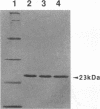Abstract
A mutant toxin, R7, of thermostable direct hemolysin (TDH) with a single amino acid substitution at glycine 62 was analyzed. The hemolytic activity of R7 decreased to less than 1/1,000 of that of wild-type TDH, and its mouse lethality was undetectable. This mutant toxin, however, showed a marked inhibitory effect on hemolysis by wild-type TDH. Enzyme immunoassay and flow cytometric analysis demonstrated that R7 retained approximately 50% of the ability to bind to erythrocytes compared with that of wild-type TDH, suggesting that its inhibition of hemolysis by wild-type TDH might be due to blocking the binding sites on the erythrocyte membrane. Wild-type TDH affected the erythrocyte membrane by causing an influx of calcium and propidium iodide, while R7 showed no detectable effects of these kinds. These results suggest that hemolysis by TDH consists of at least two steps, binding and postbinding, and that R7 is likely to be a postbinding activity-deficient mutant toxin of TDH.
Full text
PDF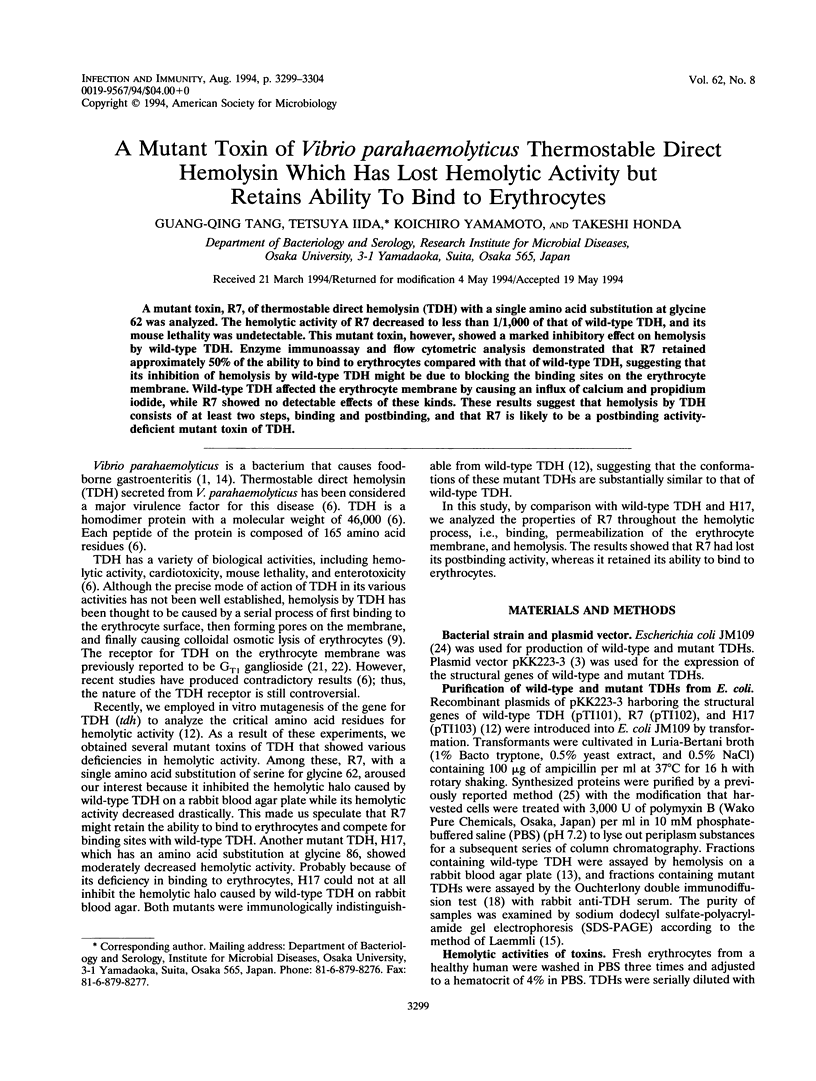
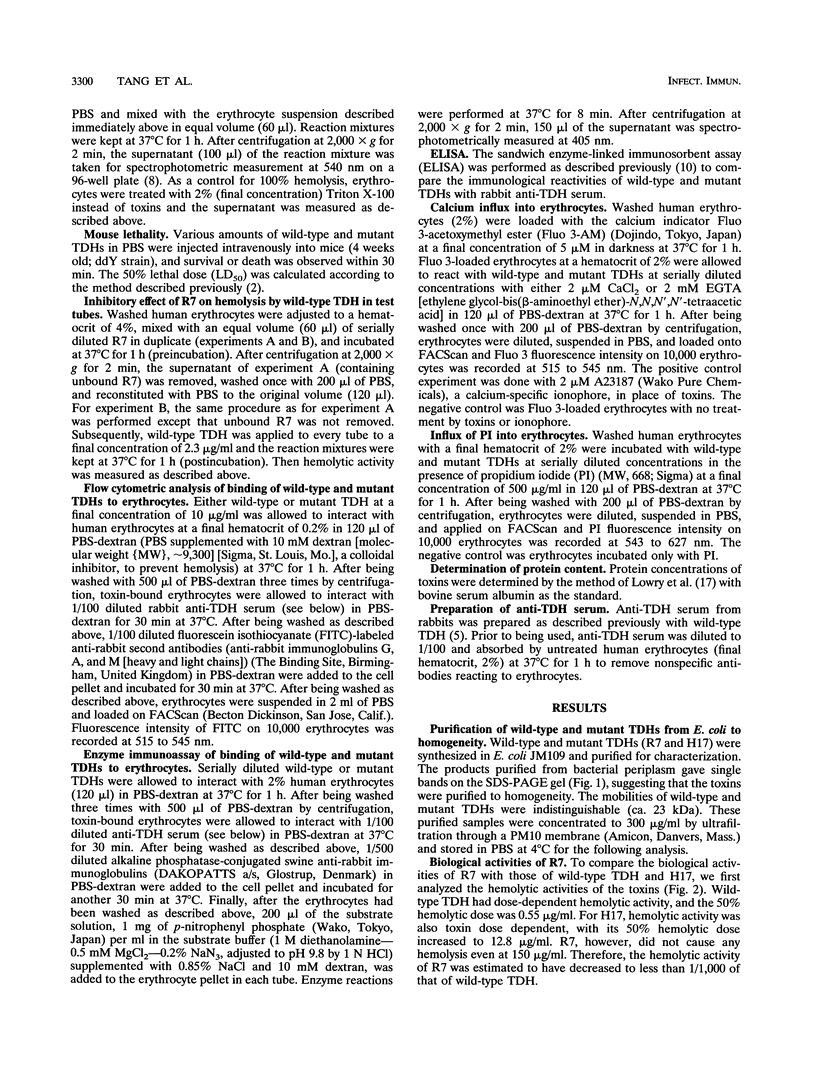
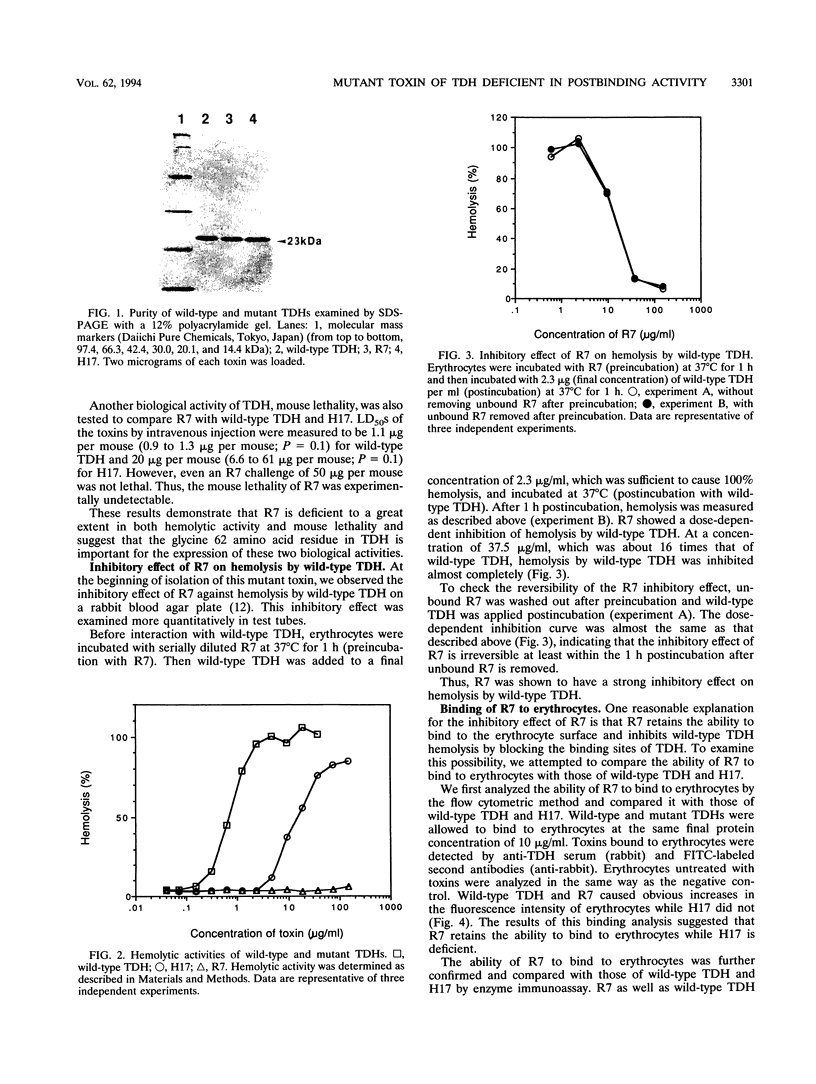
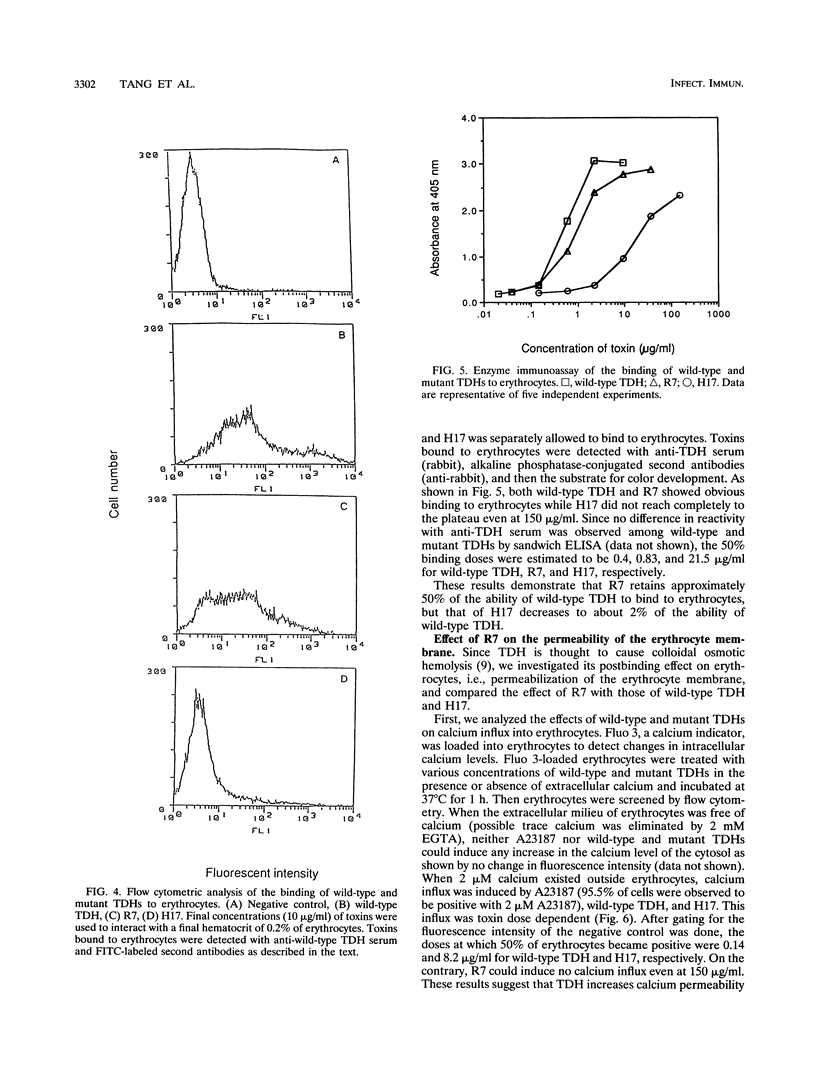
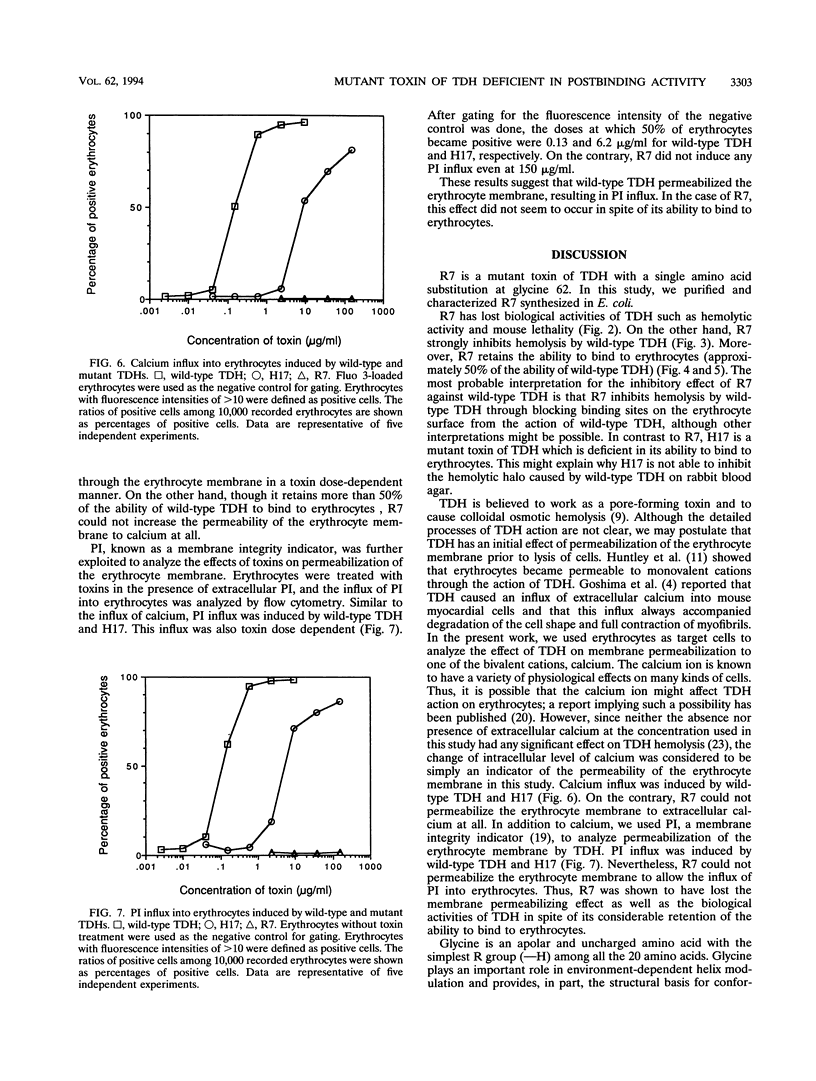
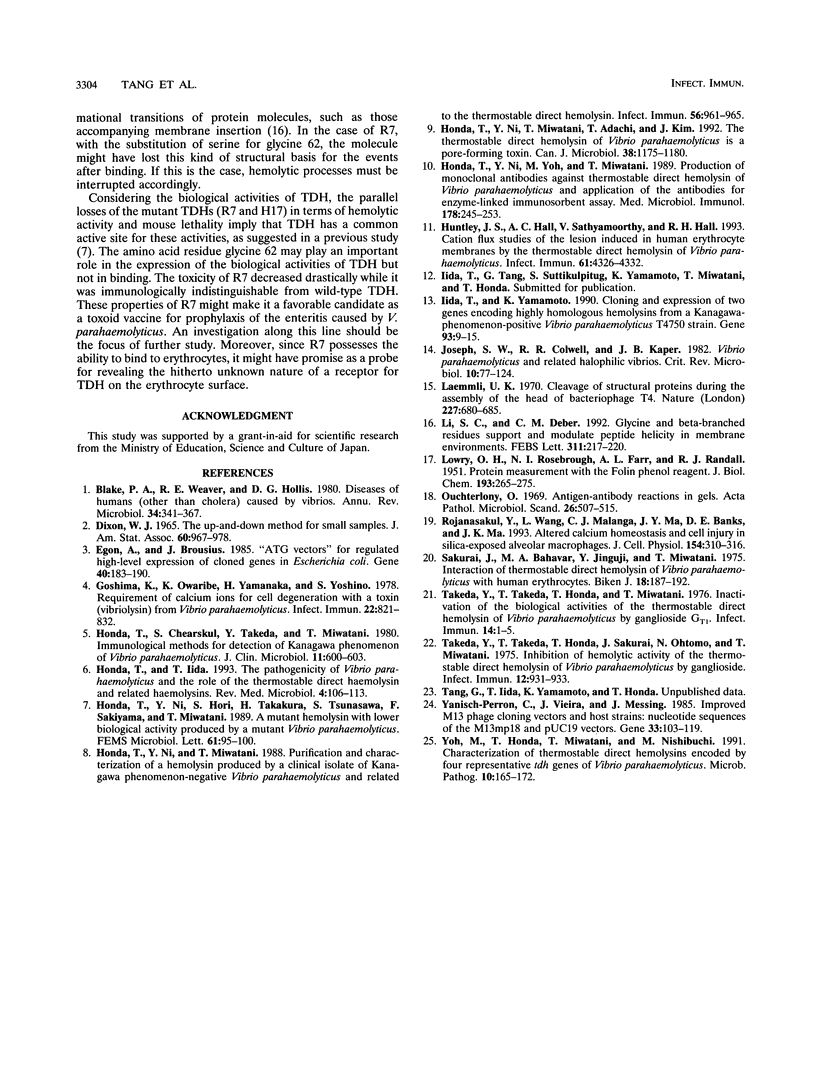
Images in this article
Selected References
These references are in PubMed. This may not be the complete list of references from this article.
- Amann E., Brosius J. "ATG vectors' for regulated high-level expression of cloned genes in Escherichia coli. Gene. 1985;40(2-3):183–190. doi: 10.1016/0378-1119(85)90041-1. [DOI] [PubMed] [Google Scholar]
- Blake P. A., Weaver R. E., Hollis D. G. Diseases of humans (other than cholera) caused by vibrios. Annu Rev Microbiol. 1980;34:341–367. doi: 10.1146/annurev.mi.34.100180.002013. [DOI] [PubMed] [Google Scholar]
- Goshima K., Owaribe K., Yamanaka H., Yoshino S. Requirement of calcium ions for cell degeneration with a toxin (vibriolysin) from Vibrio parahaemolyticus. Infect Immun. 1978 Dec;22(3):821–832. doi: 10.1128/iai.22.3.821-832.1978. [DOI] [PMC free article] [PubMed] [Google Scholar]
- Honda T., Chearskul S., Takeda Y., Miwatani T. Immunological methods for detection of Kanagawa phenomenon of Vibrio parahaemolyticus. J Clin Microbiol. 1980 Jun;11(6):600–603. doi: 10.1128/jcm.11.6.600-603.1980. [DOI] [PMC free article] [PubMed] [Google Scholar]
- Honda T., Ni Y. X., Hori S., Takakura H., Tsunasawa S., Sakiyama F., Miwatani T. A mutant hemolysin with lower biological activity produced by a mutant Vibrio parahaemolyticus. FEMS Microbiol Lett. 1989 Oct 1;52(1-2):95–100. doi: 10.1016/0378-1097(89)90177-8. [DOI] [PubMed] [Google Scholar]
- Honda T., Ni Y. X., Miwatani T. Purification and characterization of a hemolysin produced by a clinical isolate of Kanagawa phenomenon-negative Vibrio parahaemolyticus and related to the thermostable direct hemolysin. Infect Immun. 1988 Apr;56(4):961–965. doi: 10.1128/iai.56.4.961-965.1988. [DOI] [PMC free article] [PubMed] [Google Scholar]
- Honda T., Ni Y., Miwatani T., Adachi T., Kim J. The thermostable direct hemolysin of Vibrio parahaemolyticus is a pore-forming toxin. Can J Microbiol. 1992 Nov;38(11):1175–1180. doi: 10.1139/m92-192. [DOI] [PubMed] [Google Scholar]
- Honda T., Ni Y., Yoh M., Miwatani T. Production of monoclonal antibodies against thermostable direct hemolysin of Vibrio parahaemolyticus and application of the antibodies for enzyme-linked immunosorbent assay. Med Microbiol Immunol. 1989;178(5):245–253. doi: 10.1007/BF00191059. [DOI] [PubMed] [Google Scholar]
- Huntley J. S., Hall A. C., Sathyamoorthy V., Hall R. H. Cation flux studies of the lesion induced in human erythrocyte membranes by the thermostable direct hemolysin of Vibrio parahaemolyticus. Infect Immun. 1993 Oct;61(10):4326–4332. doi: 10.1128/iai.61.10.4326-4332.1993. [DOI] [PMC free article] [PubMed] [Google Scholar]
- Iida T., Yamamoto K. Cloning and expression of two genes encoding highly homologous hemolysins from a Kanagawa phenomenon-positive Vibrio parahaemolyticus T4750 strain. Gene. 1990 Sep 1;93(1):9–15. doi: 10.1016/0378-1119(90)90129-f. [DOI] [PubMed] [Google Scholar]
- Joseph S. W., Colwell R. R., Kaper J. B. Vibrio parahaemolyticus and related halophilic Vibrios. Crit Rev Microbiol. 1982;10(1):77–124. doi: 10.3109/10408418209113506. [DOI] [PubMed] [Google Scholar]
- LOWRY O. H., ROSEBROUGH N. J., FARR A. L., RANDALL R. J. Protein measurement with the Folin phenol reagent. J Biol Chem. 1951 Nov;193(1):265–275. [PubMed] [Google Scholar]
- Laemmli U. K. Cleavage of structural proteins during the assembly of the head of bacteriophage T4. Nature. 1970 Aug 15;227(5259):680–685. doi: 10.1038/227680a0. [DOI] [PubMed] [Google Scholar]
- Li S. C., Deber C. M. Glycine and beta-branched residues support and modulate peptide helicity in membrane environments. FEBS Lett. 1992 Oct 26;311(3):217–220. doi: 10.1016/0014-5793(92)81106-v. [DOI] [PubMed] [Google Scholar]
- Rojanasakul Y., Wang L., Malanga C. J., Ma J. Y., Banks D. E., Ma J. K. Altered calcium homeostasis and cell injury in silica-exposed alveolar macrophages. J Cell Physiol. 1993 Feb;154(2):310–316. doi: 10.1002/jcp.1041540214. [DOI] [PubMed] [Google Scholar]
- Sakurai J., Bahavar M. A., Jinguji Y., Miwatani T. Interaction of thermostable direct hemolysin of Vibrio parahaemolyticus with human erythrocytes. Biken J. 1975 Dec;18(4):187–192. [PubMed] [Google Scholar]
- Takeda R., Honda T., Sakural J., Otomo N. Inhibition of hemolytic activity of the thermostable direct hemolysin of Vibrio parahaemolyticus by ganglioside. Infect Immun. 1975 Oct;12(4):931–933. doi: 10.1128/iai.12.4.931-933.1975. [DOI] [PMC free article] [PubMed] [Google Scholar]
- Takeda Y., Takeda T., Honda T., Miwatani T. Inactivation of the biological activities of the thermostable direct hemolysin of Vibrio parahaemolyticus by ganglioside Gt1. Infect Immun. 1976 Jul;14(1):1–5. doi: 10.1128/iai.14.1.1-5.1976. [DOI] [PMC free article] [PubMed] [Google Scholar]
- Yanisch-Perron C., Vieira J., Messing J. Improved M13 phage cloning vectors and host strains: nucleotide sequences of the M13mp18 and pUC19 vectors. Gene. 1985;33(1):103–119. doi: 10.1016/0378-1119(85)90120-9. [DOI] [PubMed] [Google Scholar]
- Yoh M., Honda T., Miwatani T., Nishibuchi M. Characterization of thermostable direct hemolysins encoded by four representative tdh genes of Vibrio parahaemolyticus. Microb Pathog. 1991 Feb;10(2):165–172. doi: 10.1016/0882-4010(91)90077-n. [DOI] [PubMed] [Google Scholar]



